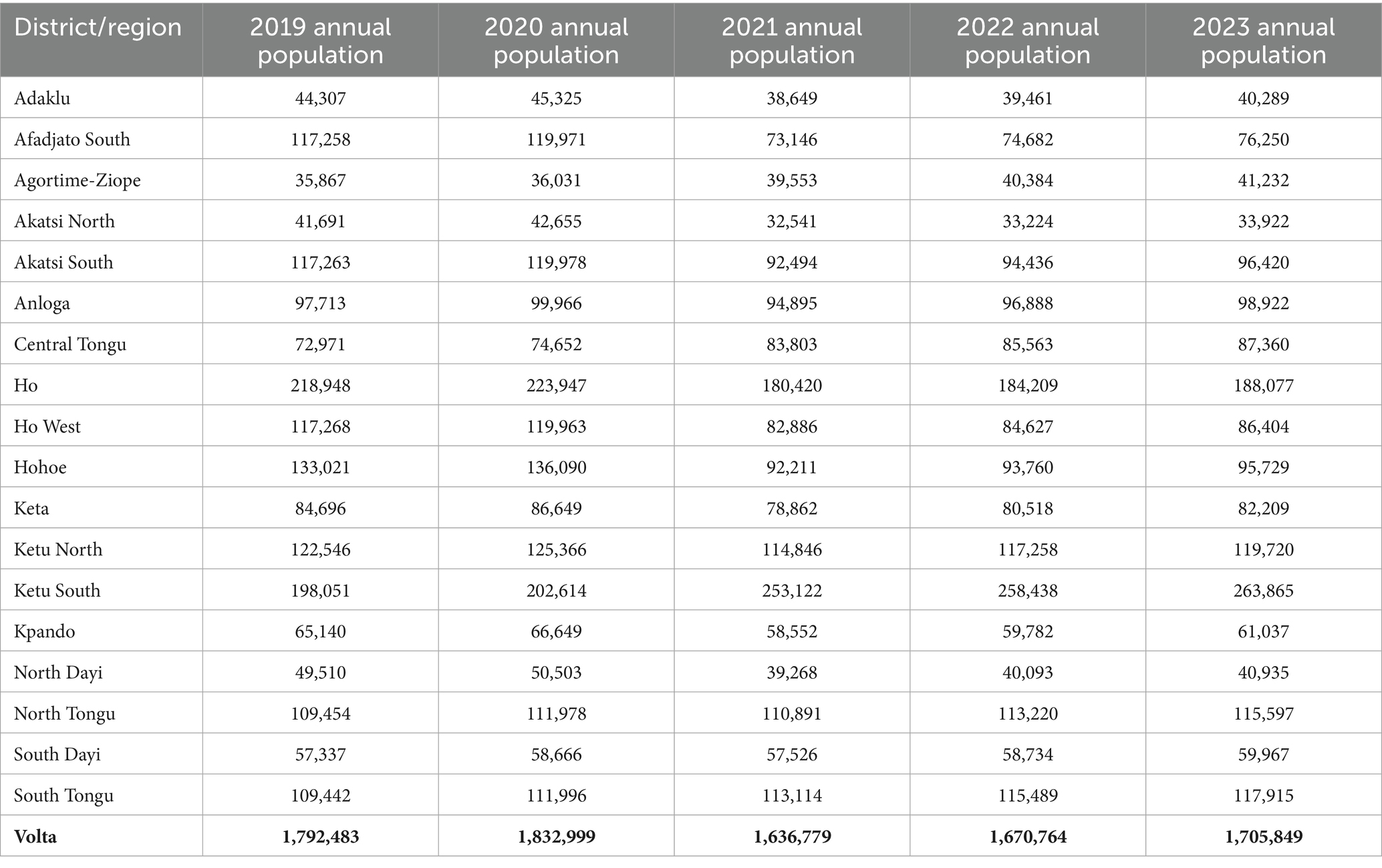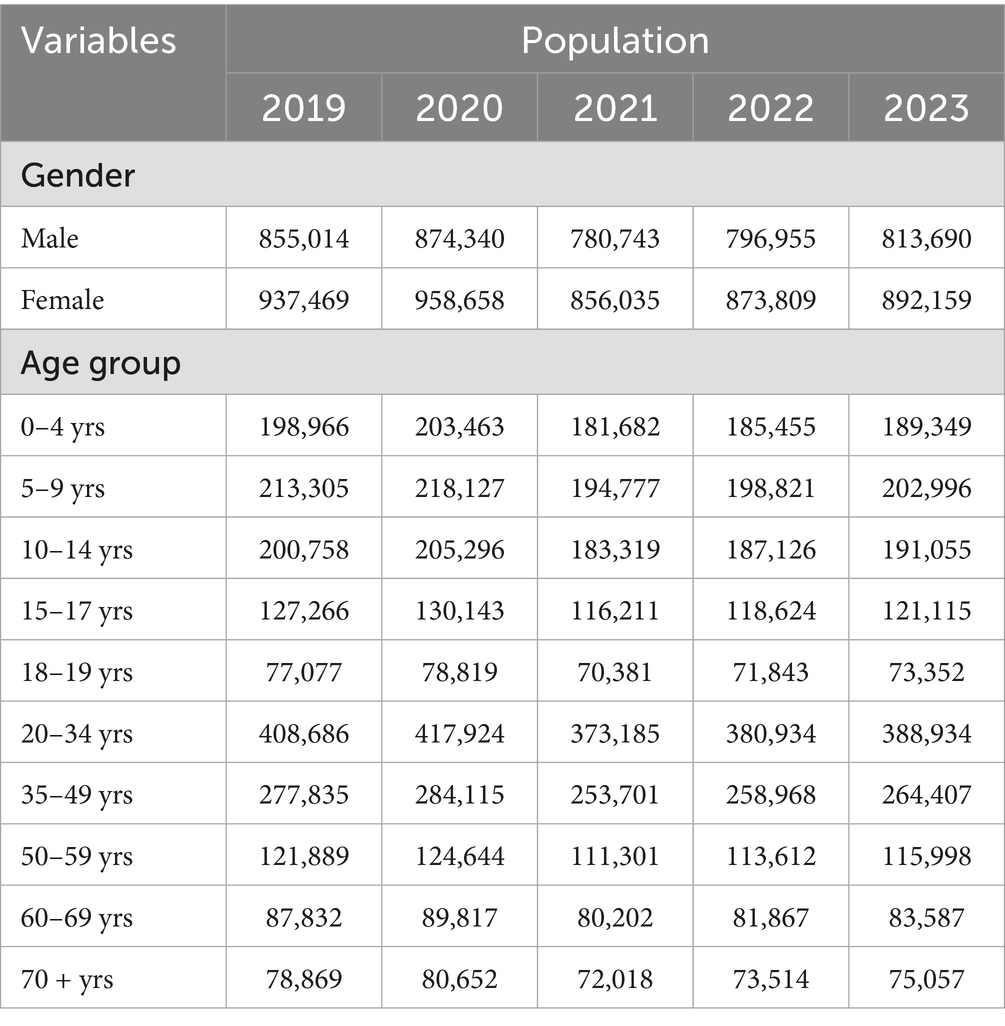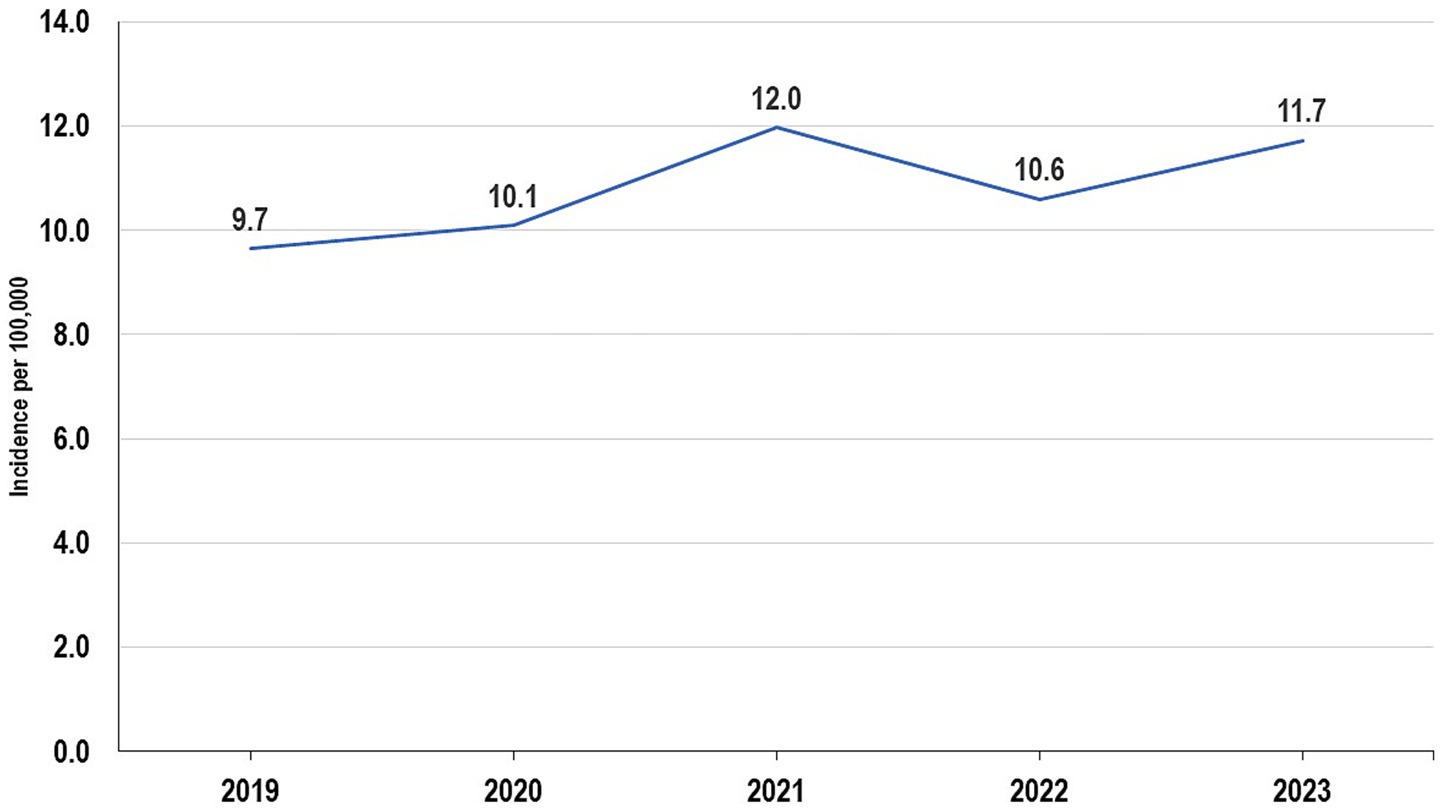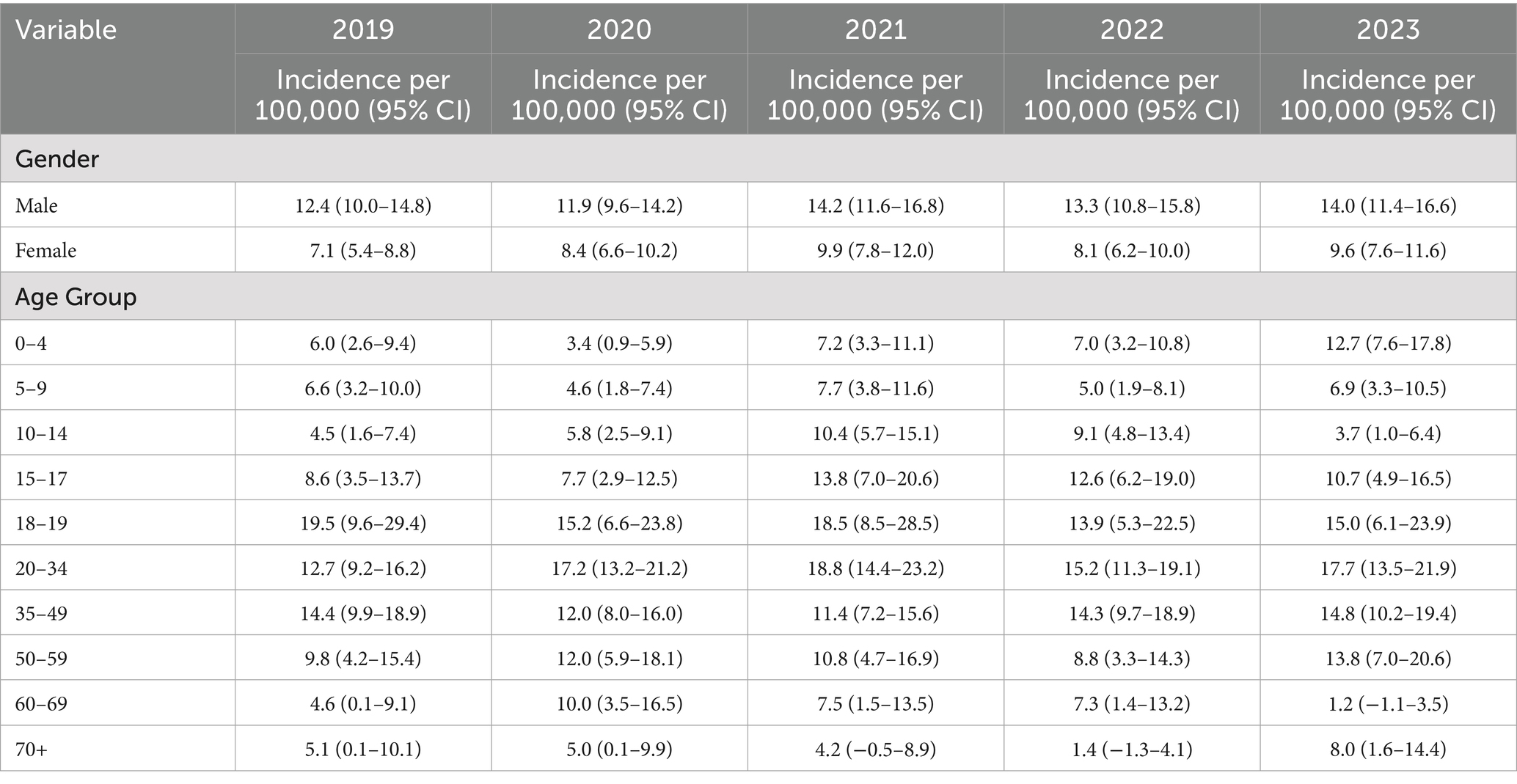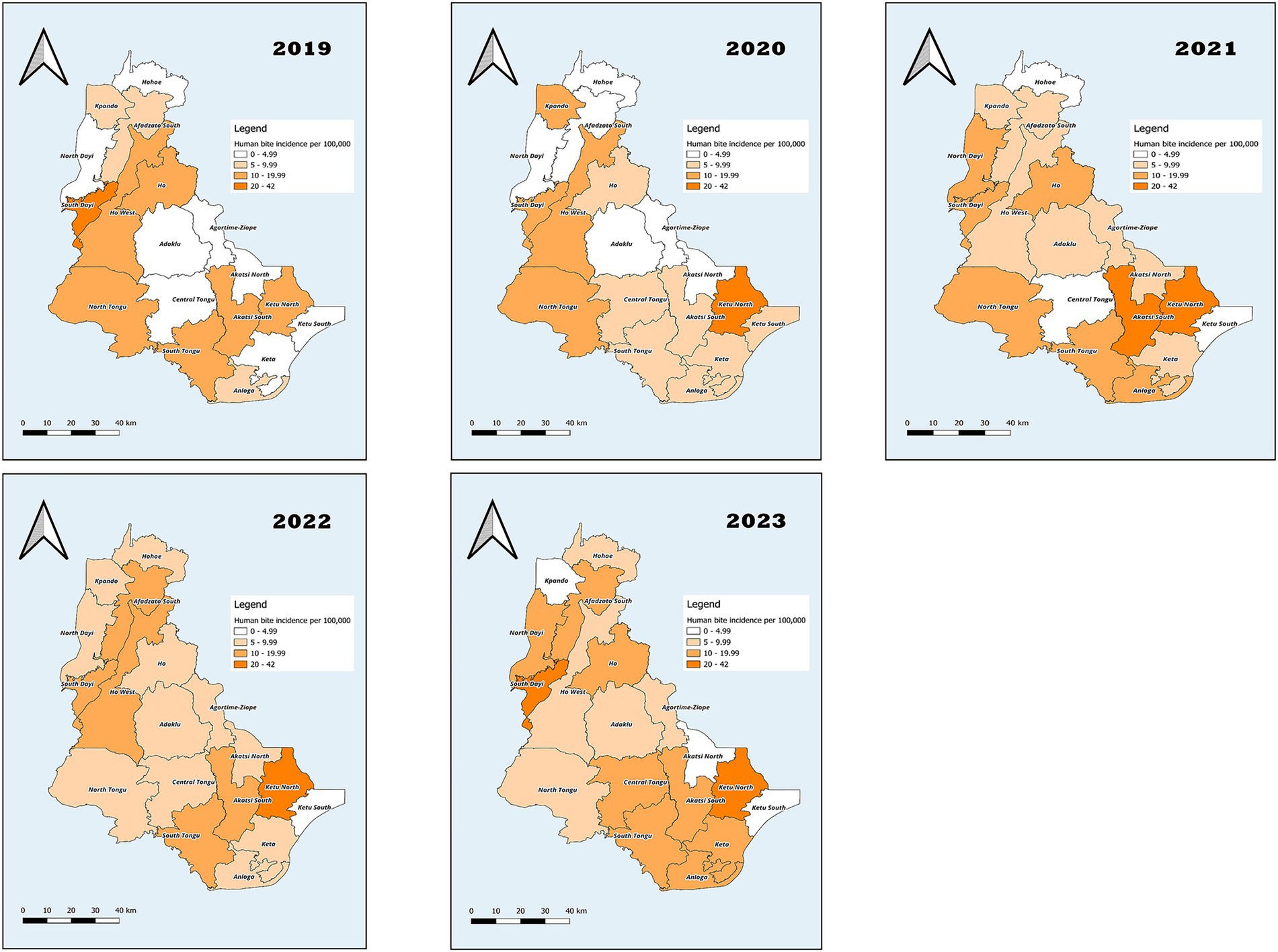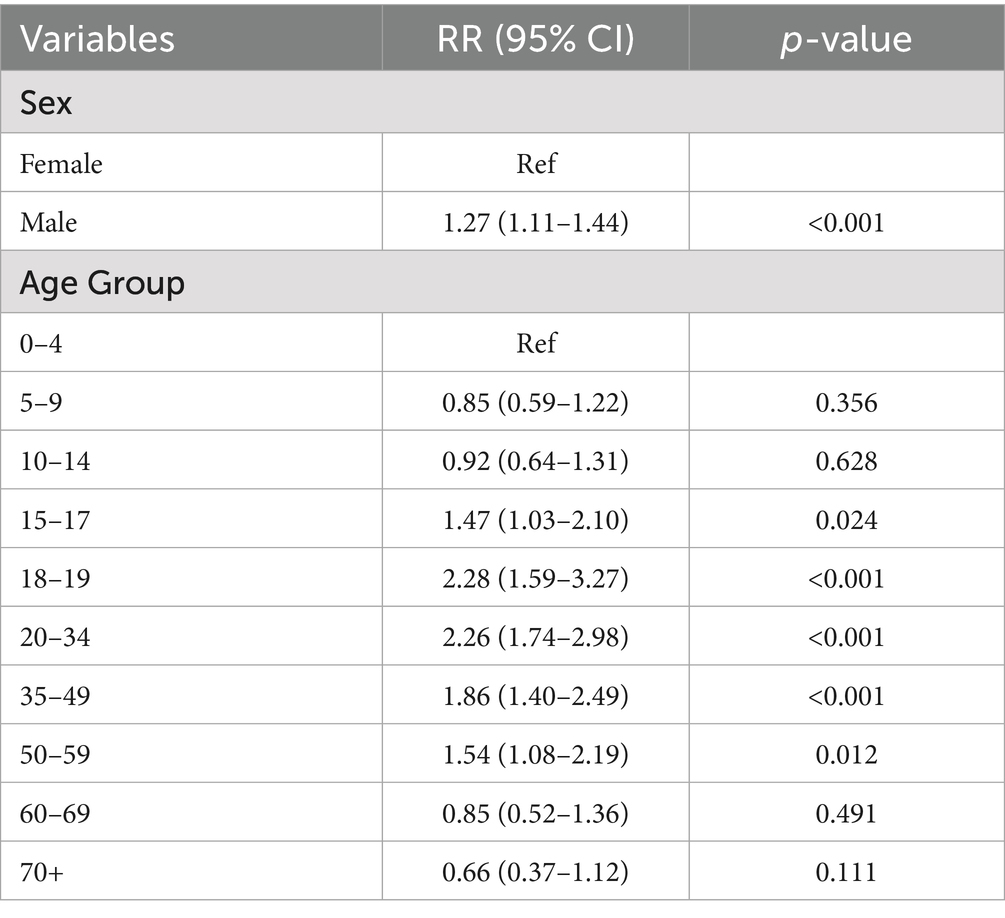- 1Volta Regional Health Directorate, Ghana Health Service, Ho, Ghana
- 2Department of Epidemiology and Biostatistics, Fred N. Binka School of Public Health, University of Health and Allied Sciences, Ho, Ghana
- 3Health Information Unit, Volta Regional Health Directorate, Ghana Health Service, Ho, Ghana
- 4Disease Surveillance Unit, Volta Regional Health Directorate, Ghana Health Service, Ho, Ghana
- 5Saboba District Health Directorate, Ghana Health Service, Saboba, Ghana
- 6WHO Country Office, Accra, Ghana
- 7Laboratory Department, Tamale Teaching Hospital, Tamale, Ghana
Introduction: Although human bite injuries occur less frequently than other types of injuries, they present notable public health challenges, yet they have received relatively little attention. This study examined the incidence, trend, and distribution of human bite injuries in the Volta Region of Ghana from 2019 to 2023.
Method: A retrospective analysis of human bite injury data from the District Health Information Management System 2 (DHIMS-2) for the Volta Region was conducted for the period 2019 to 2023. Data on human bite injuries were obtained from the monthly outpatient (OPD) morbidity report form. Variables available and extracted were age, sex, district and year of report. The data was analyzed descriptively using Microsoft Excel and Quantum Geographic Information System (QGIS) and the findings presented in tables and graphs.
Result: A total of 931 human bite injuries were reported to health facilities from 2019 to 2023, with the highest incidence of 12.0 per 100,000 recorded in 2021 and the lowest, 9.7 per 100,000 in 2019. Males and young adults between the ages of 18–34 accounted for 58.1 and 41.1%, respectively of all cases reported. Geographically, Ketu North recorded the highest number of cases, 184 (19.8%). There we no reported death due to human bite.
Conclusion: Human bite injuries in the Volta Region have shown an upward trend over the years studied, with males and young adults aged 18 to 34 years affected in the majority of the reported cases. While the causes and infection outcomes were not determined, this study provides essential baseline data for further research into the causes and effects of these injuries.
Background
Human bites are regarded as a significant public health issue around the globe. It is considered the third most common bite injury behind dog and cat bites (1). Human bites are often underestimated, but literature has it that they can lead to significant infections in the victims (2). Similar to monkey bites, human bites are generally more serious and more prone to infections and complications than those infected by other animals (3). Because there are more resident germs in the human mouth than in the mouths of dogs or cats, human bites usually infect the victim with more bacteria (4). Anaerobic bacteria often infect such wounds as a result of these bites (5). Findings from studies conducted in the United States have indicated that approximately 10% of human bites in infants would end in infection (6). With an increasing population, these bites can significantly increase with a pronounced rise in developing nations (7).
According to US estimates, one in two people will get bitten at some point in their lives, either by an animal or by a human (3). Human bites account for 3% of total bites seen at emergency departments (8). In some under-developed and developing countries in Africa, human bites are relatively common (9). However, studies conducted within these regions have primarily focused on human bites occurring at the oro-facial region of the human body (9–11). This inference could mean that most of these injuries occur in the head region. A study conducted across 12 African countries in 2020 on traumatic injuries revealed that out of a total of 200 cases seen, 51(25.5%) were as a result of human bites and these injuries occurred in the facial region (9). Most of these human bite injuries occurring in the orofacial region are a result of social conflicts (10). One of the two studies done on human bites in Ghana was in 2016 at the Komfo Anokye Teaching Hospital, which aimed to provide a general overview of orofacial human bites with a focus on etiology, presentations, anatomic locations, treatment, and outcome of treatment (11). Findings from the study showed that most of the offenders are known to the patients because they are rivals (11). Considering the fact that the incidence of human bite could increase due to potential rise in social conflicts, close contact activities and crowded living conditions (9), there is a need to review existing data to estimate the incidence, population at risk and identify patterns.
Human bites, although preventable, continue to represent a significant public health concern in both developing and developed regions. In Ghana, there has been insufficient research regarding the incidence, age distribution, and other demographic risk factors of human bite cases. Furthermore, there are currently no established national preventive or intervention strategies to address this issue. This situation underscores the urgent need for heightened public awareness and additional research. However, this will be based on baseline data. Therefore, this study aimed to examine the incidence, trends and geographic distribution of human bite cases reported in the Volta Region between 2019 and 2023.
Methods
Study design and setting
A retrospective analysis of aggregated secondary data was performed to describe human bite cases in the Volta Region of Ghana for the years 2019 to 2023. The Volta Region consist of 18 districts with an estimated population of 1.7 million people, with Ho as its capital city. The observed decrease in the Volta Region’s population between 2020 and 2021 is because the 2020 figure was a projection based on the 2010 census, while the 2021 figure comes from the actual 2021 census. The most populated district in the region is Ketu South Municipality, followed by Ho Municipality and Ketu North Municipality (Table 1). The predominant occupation in the region is farming, with most indigenes residing in rural communities. Fishing occurs along the coast and in communities along the Volta Lake (12). The Alavanyo-Nkonya conflict, which has been ongoing sporadically since 1923, is located in the Volta Region (13). The Volta Region currently has a total of 557 health facilities, with the majority of which are Community-based Health Planning Service (CHPS) compounds. The region has one Teaching Hospital, however, there are six districts without a primary hospital (14). The Volta Region was chosen for this review because there has not been any study on human bites in the region and ranks among the top 3 regions with the highest prevalence of domestic violence in Ghana (15). The region also experiences recurring community conflicts, such as the long-standing Alavanyo–Nkonya dispute, which reflects underlying social tension. Despite these conditions, there has been no prior study on human bite injuries in the region. Examining human bite patterns in this setting therefore provides important baseline information for understanding the burden and potential social drivers of such injuries in Ghana.
Data collection and processing
All registered health facilities in the Volta Region have access to an electronic health record platform known as the District Health Information Management System-2 (DHIMS-2). This system facilitates the compilation of monthly data generated at each facility. When a client presents to a health facility with an injury, such as a human bite, demographic information, including age and sex, is recorded either electronically or in physical registers, along with the clinician’s diagnosis. At the end of each month, a summary of all new health conditions is prepared using the outpatient morbidity form, which is then entered into DHIMS-2 (13). For this study, the data visualization feature within DHIMS-2 was used to extract relevant information. As the data is reported by age and sex, the study was able to retrieve variables for age, sex, year, and the districts where human bite cases were documented and reported. To extract data on mortalities as a result of human bite, the Cause of Death (CoD) instance of the DHIMS was utilized. The event report page of the CoD instance was used to extract the number of deaths due to human bite.
Data analysis
Data was analyzed descriptively based on person, place and time. The results were reported as frequencies and proportions. The QGIS software was used to geographically describe the distribution of the cases in the Volta Region. Incidence rate was calculated by dividing the number of cases reported by the total population within a specific year. Using estimates from the population and housing census, the age and sex specific populations were calculated. These estimates were used to compute the age and sex specific incidence (Table 2). District-specific incidence was also computed using the district-specific population by year (Table 1). The incidence was reported per 100,000 population with their respective 95% confidence intervals.
Results
Characteristics of reported human bites
Over the 5 years, a total of 931 cases of human bites were recorded, of which 541 (58.1%) were males. There was no recorded mortality. In terms of age groupings, 321 (34.5%) of cases aged 20–34 years and 179 (19.2%) were between the ages of 35–49 years. Children less than 5 years old were 69 (7.4%). The majority of the cases were reported in 2023, 200 (21.5%). In terms of locations where these cases were reported, 184 (19.8%) human bites were recorded in Ketu North, 122 (13.1%) in Ho, and 85 (9.1%) in Akatsi North (Table 3).
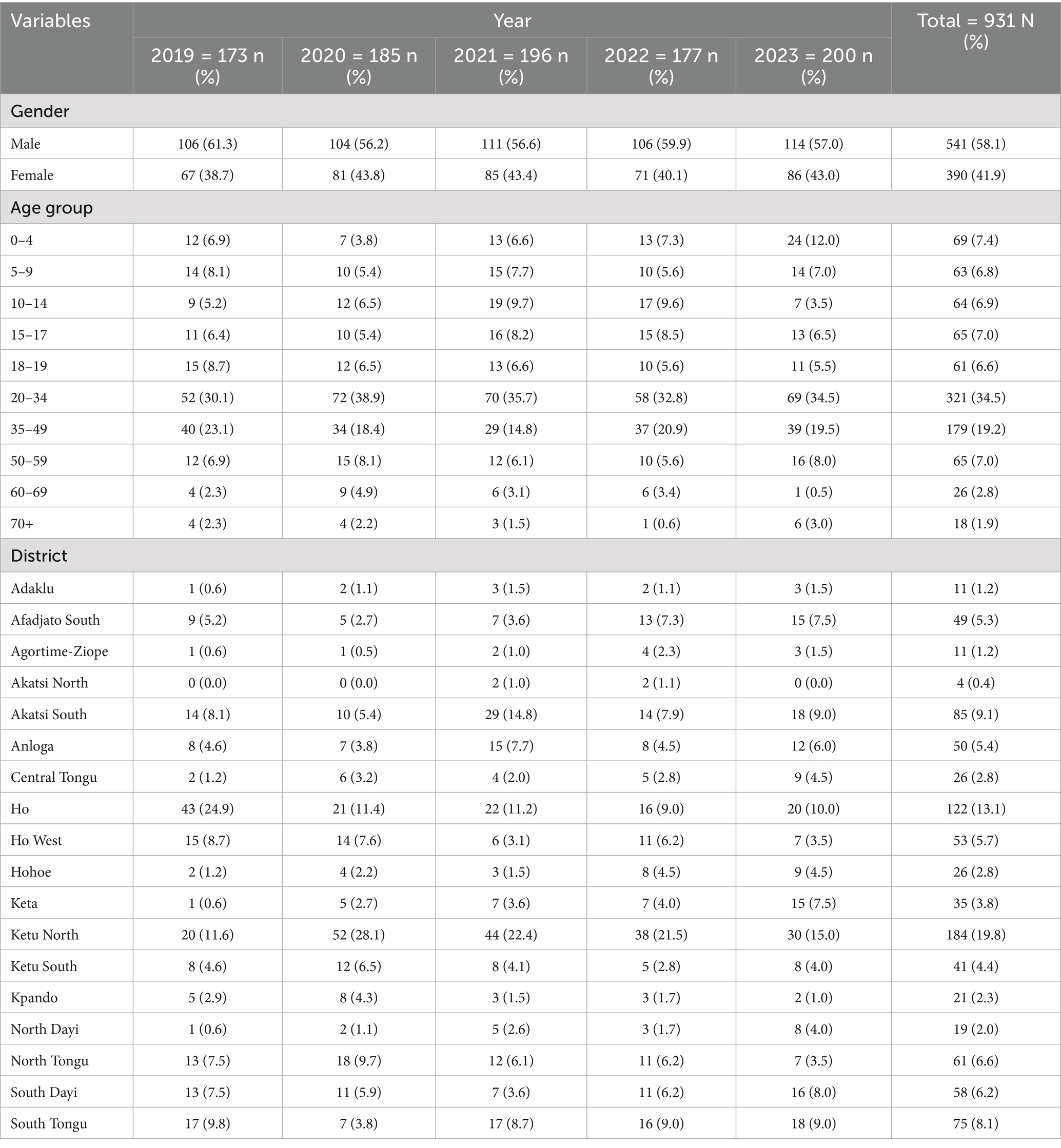
Table 3. Characteristics of human bites reported to health facilities in the Volta Region, 2019–2023.
Incidence of human bites in the Volta region, 2019–2023
In 2019, the incidence of human bites was 9.7 per 100,000 (Figure 1). The incidence was highest among males, 12.4 per 100,000 (95% CI: 10.0–14.8) and among persons aged 18–19 years, 19.5 per 100,000 (95% CI: 9.6–29.4; Table 4). Geographically, the incidence was highest in South Dayi, 22.7 per 100,000 (Figure 2). In 2020, the incidence of human bites increased to 10.1 per 100,000 (Figure 1). The incidence was lowest among females, 8.4 per 100,000 (95% CI: 6.6–10.2) but highest among persons aged 20–34 years, 17.2 per 100,000 (95% CI: 13.2–21.2; Table 4). Geographically, the incidence was highest in Ketu North, 41.5 per 100,000 (Figure 2). In 2021, the incidence further increased to 12.0 per 100,000 (Figure 1), resulting in a further increase in the incidence among persons aged 20–34 years, 18.8 (95% CI: 14.4–23.2; Table 4). There was, however, a decrease in incidence in Ketu North, 38.3 per 100,000, though it still remained the district with the highest incidence (Figure 2).
In 2022, there was a decrease in the incidence of human bites, 10.6 per 100,000 (Figure 1). This affected the incidence among males, 13.3 per 100,00 (95% CI: 10.8–15.8) and also on persons aged 20–34 years, 15.2 (95% CI: 11.3–19.1; Table 4). In 2023, the incidence increased to 11.7 per 100,000 (Figure 1). As a result, there was an increase in incidence among males, 14.0 (95% CI: 11.4–16.6), which is the highest across the 5 years studied. The incidence among persons aged 20–34 years was 17.7 per 100,000 (13.5–21.9; Table 4). Geographically, the incidence was highest in South Dayi, 26.7 per 100,000 (Figure 2).
Compared to females, males had a significantly higher risk of human bite incidents (RR = 1.27, 95% CI: 1.11–1.44, p < 0.001). The risk of bites increased progressively with age, peaking among individuals aged 18–19 years (RR = 2.28, 95% CI: 1.59–3.27, p < 0.001) and 20–34 years (RR = 2.26, 95% CI: 1.74–2.98, p < 0.001), relative to children aged 0–4 years. Older adults (≥60 years) had a comparatively lower but non-significant risk. Overall, the results indicate that males and younger adults are at the greatest risk of human bite incidents (Table 5).
Discussion
This study investigated the occurrence, trends, and patterns of human bites in the Volta Region of Ghana. A five-year analysis of human bites provided important insights into the incidence rates, demographic characteristics, and geographic disparities across the region. Findings from this study show that there seems to be an increase in the incidence of human bites over the years studied. Although the study did not establish the exact reason for the increase, surge in domestic violence in the region, may have contributed to this upward trend. The Ghana demographic and health survey indicated that the percentage of women aged 15–49 who have ever experienced domestic violence in the Volta region increased from 34.7% in 2008 to 40.3% in 2022. This places the Volta region in the top 3 regions with the highest prevalence (15).
This study offers important insights into the trends and demographic patterns of human bite cases in the Volta Region. However, the findings should be interpreted with caution because of the limitations of the DHIMS-2 data. Although DHIMS-2 captures routine health facility information, it lacks clinical and contextual details. It does not capture how the bite occurred, who the aggressor was, the body part affected, or the type and outcome of treatment. These gaps limit our ability to identify behavioral, social, and clinical factors that influence human bite incidents and their severity. Our study could only describe demographic and geographic patterns but could not assess causality or the risk of complications such as infections or hospital admissions. Despite these limitations, our study provides useful baseline data on the epidemiology of human bites in Ghana. The findings highlight the need to improve surveillance systems to include more detailed information. Enhancing DHIMS-2 to capture variables on injury mechanisms, treatment, and outcomes would support deeper analysis and better public health action. We recommend future studies should combine DHIMS-2 data with qualitative or hospital-based data to give a complete picture of the causes and effects of human bites in the region.
More males were affected compared to females. The district with the highest incidence is Ketu North and the lowest incidence was reported in Akatsi North. Although these estimates are lower than other diseases of public health concern within the region, there is a need to put in measures to curb the occurrence of these incidents, as human bites are generally more infectious than other animal bites (3). The plausible reasons for the differences in incidence across the districts could be related to population distribution. Districts such as Ketu North, which share borders with Togo, are more densely populated and experience higher cross-border trade and mobility. Increased population movement and social interaction in these settings may elevate the risk of interpersonal conflicts that lead to human bites. In contrast, smaller and more rural districts such as Akatsi North or Adaklu have lower population density and fewer social contact points, possibly explaining their lower incidence. In addition, variations in the strength of surveillance systems across districts may influence data accuracy, with some districts capturing and reporting cases more effectively than others. Although these explanations are speculative, they align with earlier reports linking human bites to domestic and social conflicts in African contexts (7, 10, 16). These findings further emphasize the need for further studies that explore the social and behavioral drivers of these injuries to design effective prevention strategies.
In our study, we reported a higher proportion of human bites among males compared to females. This is consistent with studies from Ghana and the US, which found that the majority of human bite victims are males (17–19). It is not surprising to see more males being victims of human bites because males are generally more aggressive and are involved in more risky behaviors such as fights, than females (20, 21). Also, in a physical altercation between a man and a woman, it is uncommon for the man to resort to biting. Typically, the woman is more likely to bite in self-defense. In contrast, studies conducted in several African countries, including Ghana, have found more females being victims of human bites (9–11, 22, 23). In the African settings where polygamy is practiced (24), co-wives often engage in physical altercations driven by jealousy, which can lead to one biting the other in an attempt to disfigure her rival (9). This may explain why studies have found a higher proportion of women being victims of human bites. The difference in estimates could be due to the fact that our study focused on all types of human bite injuries reported to the health facilities, whereas studies that reported higher proportions among females used data on persons who had orofacial human bite.
Our study found 34.5% of victims of human bites aged 20–34 years. In terms of incidence, the results show that persons aged 18–34 years are the most victims of human bites. This agrees with findings by Shubi et al., who found 45.5% of persons aged 20–29 years as victims of human bite (10). Also, Osaiyuwu & Osaguona found 38.5% of persons aged 28–37 years as victims of human bite (22). The high incidence among young adults correlates with the assertion that young adults are usually persons who are involved in conflicts, which results in physical altercation, because it is at this age that they begin intimate relationships (24). The relative risk analysis further supports these demographic trends. Males were about 27% more likely to experience human bite injuries than females, consistent with findings from previous studies in Ghana (11) and elsewhere (10) that associate aggressive behavior and interpersonal violence more commonly with men. Similarly, the risk peaked among young adults aged 18–34 years, the age group most likely to be involved in social or physical confrontations. These results suggest that targeted prevention and conflict resolution programs for young men could help reduce such incidents.
Limitations and strengths
This study had important limitations. First, the DHIMS-2 data captured inadequate characteristics of human bite injuries. The cause and the affected areas were not routinely recorded. Furthermore, who did the biting, the type of treatment given and the outcome of the bite were not captured by the data source that was used for this analysis. The limited data variability restricted the level of analysis of the data for this study. Additionally, only human bite injuries reported at health facilities were included for this study, potentially underrepresenting the actual situation in the region. Despite these limitations, this study is the first to determine the rate, trend, and distribution of human bite injuries in the Volta Region of Ghana.
Conclusion
The incidence of human bite injuries in the Volta Region appears to have risen over the years under study. While the incidence remains lower compared to other public health-related injuries in the region, it is essential to address this upward trend. Although our findings did not identify the specific causes of these injuries or their outcomes, we believe this study offers valuable baseline data for further research into the potential causes and outcomes of such injuries.
Data availability statement
The original contributions presented in the study are included in the article/Supplementary material, further inquiries can be directed to the corresponding author.
Ethics statement
Ethical approval was not required for the study involving humans in accordance with the local legislation and institutional requirements. Written informed consent to participate in this study was not required from the participants or the participants' legal guardians/next of kin in accordance with the national legislation and the institutional requirements.
Author contributions
CK: Conceptualization, Data curation, Methodology, Writing – original draft, Writing – review & editing, Project administration. MA: Conceptualization, Data curation, Formal analysis, Methodology, Visualization, Writing – original draft, Writing – review & editing. SB: Conceptualization, Data curation, Formal analysis, Methodology, Visualization, Writing – original draft, Writing – review & editing. WA: Conceptualization, Writing – original draft, Writing – review & editing. VZ: Conceptualization, Data curation, Formal analysis, Methodology, Writing – original draft, Writing – review & editing. CT: Writing – review & editing. GI: Formal analysis, Writing – review & editing. CN: Formal analysis, Writing – review & editing. FB: Writing – review & editing.
Funding
The author(s) declare that no financial support was received for the research and/or publication of this article.
Acknowledgments
The authors express their gratitude to the District Health Directorates and health facility heads in the Volta Region for their efforts in collating and entering the data into the DHIMS. We also appreciate the Volta Regional Health Directorate for granting permission to use the data for this study.
Conflict of interest
The authors declare that the research was conducted in the absence of any commercial or financial relationships that could be construed as a potential conflict of interest.
Generative AI statement
The author(s) declare that no Gen AI was used in the creation of this manuscript.
Any alternative text (alt text) provided alongside figures in this article has been generated by Frontiers with the support of artificial intelligence and reasonable efforts have been made to ensure accuracy, including review by the authors wherever possible. If you identify any issues, please contact us.
Publisher’s note
All claims expressed in this article are solely those of the authors and do not necessarily represent those of their affiliated organizations, or those of the publisher, the editors and the reviewers. Any product that may be evaluated in this article, or claim that may be made by its manufacturer, is not guaranteed or endorsed by the publisher.
Supplementary material
The Supplementary material for this article can be found online at: https://www.frontiersin.org/articles/10.3389/fpubh.2025.1575617/full#supplementary-material
Abbreviations
DHIMS, District Health Information Management System; WHO, World Health Organization; HIMS, Health Information Management System; OPD, Outpatient Department; QGIS, Quantum Geographic Information System; HIV, Human Immunodeficiency Virus;; CHPS, Community-based Health Planning and Services; US, United States.
References
1. Brook, I. Management of human and animal bite wounds: an overview. Adv Skin Wound Care. (2005) 18:197–203. doi: 10.1097/00129334-200505000-00008
2. Elkamch, H, Mesbahi, A, Brahmi, A, Hafidi, J, Gharib, N, Abassi, A, et al. Management of necrotizing fasciitis due to a human bite: case report. Int Surg J. (2024) 11:1147–51. doi: 10.18203/2349-2902.isj20241744
5. Goldstein, EJ, Citron, DM, Wield, B, Blachman, U, Sutter, VL, Miller, TA, et al. Bacteriology of human and animal bite wounds. J Clin Microbiol. (1978) 8:667–72.
6. Darvishi, M, Nava, AO, Karimi, E, Nouri, M, Meigooni, SS, and Hejripoor, SZ. Human and animal bites. Caspian J Environ Sci. (2023) 21:445–56.
7. Robsam, SO, Ihechi, EU, and Olufemi, WO. Human bite as a weapon of assault. Afr Health Sci. (2018) 18:79–89. doi: 10.4314/ahs.v18i1.12
8. Maniscalco, K., and Edens, M. A. Human bites. StatPearls - NCBI Bookshelf (2023). Available online at: https://www.ncbi.nlm.nih.gov/books/NBK430764/?report=reader (Accessed December 19, 2024).
9. Clarós, P, Końska, N, and Clarós, A. Facial human bites. Vision on STMMs in Africa. Polish. J Otolaryngol. (2020) 74:31–5.
10. Shubi, FM, Hamza, OJ, Kalyanyama, BM, and Simon, EN. Human bite injuries in the oro-facial region at the Muhimbili National Hospital. Tanzania BMC Oral Health. (2008) 8:1–8.
11. Acheampong, AO, Duah, M, Selormey, R, Donkor, P, and Bankas, D. Orofacial human bite: a six-year review of cases from Komfo Anokye teaching hospital. Open J Stomatol. (2016) 6:179–84.
12. Ghana, GS. Population and housing census: population of regions and districts. Ghana Statistical Service. (2021)
13. Penu, DA, and Essaw, DW. Geographies of peace and violence during conflict: the case of the Alavanyo-Nkonya boundary dispute in Ghana. Polit Geogr. (2019) 71:91–102. doi: 10.1016/j.polgeo.2019.03.003
14. Zeng, V, Abanga, WA, Bosoka, SA, Afetor, M, Tamal, CS, Issahaku, GR, et al. Incidence, trend and distribution of transport-related injuries reported to health facilities in the Volta region of Ghana, 2019 to 2023. BMC Public Health. (2024) 24:3309. doi: 10.1186/s12889-024-20814-0
15. Ghana Statistical Service (GSS), Ghana Health Service (GHS), ICF International. Ghana demographic and health survey. Rockville, MD: GSS, GHS, and ICF International (2022).
17. Donkor, P, and Bankas, DO. A study of primary closure of human bite injuries to the face. J Oral Maxillofac Surg. (1997) 55:479–81.
18. Merchant, RC, Fuerch, J, Becker, BM, and Mayer, KH. Comparison of the epidemiology of human bites evaluated at three US pediatric emergency departments. Pediatr Emerg Care. (2005) 21:833–8. doi: 10.1097/01.pec.0000190231.20233.9e
19. Talan, DA, Abrahamian, FM, Moran, GJ, Citron, DM, Tan, JO, and Goldstein, EJ. Emergency medicine human bite infection study group. Clinical presentation and bacteriologic analysis of infected human bites in patients presenting to emergency departments. Clin Infect Dis. (2003) 37:1481–9.
20. Patil, PD, Panchabhai, TS, and Galwankar, SC. Managing human bites. J Emerg Trauma Shock. (2009) 2:186–90.
21. Scarduzio, JA, Carlyle, KE, Harris, KL, and Savage, MW. “Maybe she was provoked” exploring gender stereotypes about male and female perpetrators of intimate partner violence. Violence Against Women. (2017) 23:89–113. doi: 10.1177/1077801216636240
22. Osaiyuwu, O, and Osaguona, AO. Human bite injuries of the orofacial region: an analysis of 26 cases in Port Harcourt, Nigeria. Craniomaxillofacial Trauma & Reconstruction Open. (2020) 5:2472751220912660.
23. Muonwe, M. Polygamy in Africa in the light of the Catholic theological thinking on marriage. Nigerian J Arts Human (NJAH). (2024) 4:7.
Keywords: human bite, incidence, trend, Volta region, Ghana
Citation: Kubio C, Afetor M, Bosoka SA, Abanga WA, Zeng V, Tamal CS, lssahaku GR, Narh CT and Baiden F (2025) Human bite cases reported to health facilities in the Volta region of Ghana, 2019 to 2023. Front. Public Health. 13:1575617. doi: 10.3389/fpubh.2025.1575617
Edited by:
Wisdom Mdumiseni Dlamini, University of Eswatini, EswatiniReviewed by:
Ellie JC Goldstein, University of California, Los Angeles, United StatesSinan Yılmaz, Atatürk University, Türkiye
Copyright © 2025 Kubio, Afetor, Bosoka, Abanga, Zeng, Tamal, lssahaku, Narh and Baiden. This is an open-access article distributed under the terms of the Creative Commons Attribution License (CC BY). The use, distribution or reproduction in other forums is permitted, provided the original author(s) and the copyright owner(s) are credited and that the original publication in this journal is cited, in accordance with accepted academic practice. No use, distribution or reproduction is permitted which does not comply with these terms.
*Correspondence: Maxwell Afetor, YWZldG9ybWF4d2VsbDRAZ21haWwuY29t
 Chrysantus Kubio1,2
Chrysantus Kubio1,2 Maxwell Afetor
Maxwell Afetor Frank Baiden
Frank Baiden